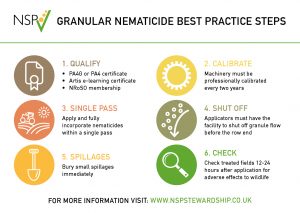The Nematicide Stewardship Programme (NSP) promotes the correct use of granular nematicides. The NSP best practice steps, which are part of the Red Tractor standards for potato growers, give guidance on how to achieve safe and responsible application.
 Qualify
Qualify
Operators have to be qualified with a PA4 or PA4G certification and must have completed the Nematicide Stewardship e-learning to apply granular nematicides. They must also be members of NRoSO.
Soil samples should be taken to establish pest pressures to inform nematicide applications. The AHDB has produced an advice guide for advice on achieving accurate PCN sampling and to help growers understand laboratory results. Click here to download your copy.
Growers should always seek advice from a BASIS qualified agronomist prior to the purchase and use of a nematicide. Recommendation sheets should be available for each treated field.
Calibrate
When applying nematicides growers should carry out the below and keep records to demonstrate that:
- The granule applicator has been inspected and certified by NSTS in the last two year
- They have checked the applicator at the start of the workday to ensure all pipework is correctly fitted, the hopper bungs are in place and hopper lids are secure
- The area treated and the product volume used match for each field
These checks should be recorded and held for three years as required by Red Tractor. There is a template to support this available on the Red Tractor website.
When the applicator is in use granules must be monitored to check they are flowing correctly.
Single pass
Granular nematicides should be applied and incorporated within a single pass with no granules left on the surface. They should be applied using a vertical (rotovator/rotospike), not horizontal (power harrow) incorporation, and not using a tined cultivator to do it. Applicators with a working width wider than the incorporation equipment should not be used.
Shut-off
All potato applicators must be fitted with a device in cab that allows the operator to shut off nematicide granule flow at least 3m before the end of the row.
For those applicators driven by a land or spider wheel, an electronic clutch can be fitted to the applicator drive shaft to enable remote shut off.
After planting growers should cultivate headlands to ensure no granules are left on the soil surface.
Spillages
Use designated filling sites for filling hoppers in each field, which can easily be checked for spillages.
If a spillage occurs, make sure to wear the appropriate PPE and follow the guidance below.
Small spillages should be buried immediately ensuring no granules are left on the surface.
In the case of a larger spillage, transfer the granules to the original container or an empty container that originally held the same product. The container should be in good condition and with an undamaged label. Access the container by removing the valve and undoing the clamp (or tie seals) around the neck.
If an original product container is not available, transfer the spilled granules into a suitable, larger container clearly labelled with the product name and the hazard classification and risk and safety phrases shown on the product label.
This should then be stored safely and returned to the manufacturer via the supplying distributor at the earliest opportunity.
Check
Check treated fields 24- 48 hours post application for any adverse effects to wildlife and record findings using the template found on the Red Tractor website. If anything is found, contact the Wildlife Incident and Investigation (WIIS) using the UK free-phone number 0800 321600, and the granule manufacturer.
- Nemathorin call Syngenta: 0800 1696058
More guidelines on field checks can be found here.


